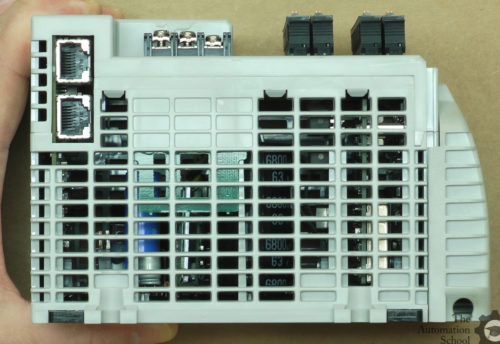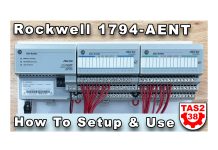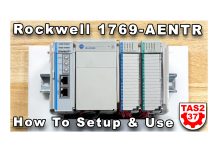
The fourth generation of CompactLogix controllers began with the release of the L1, L2, and L3 back in 2012.
 While 2012 might have been a bad year for Myan doomsayers, in was a banner year for the CompactLogix as Rockwell released not one but three new models.
While 2012 might have been a bad year for Myan doomsayers, in was a banner year for the CompactLogix as Rockwell released not one but three new models.
While each model was physically different, unlike previous iterations all three shared a large number of features.
The 5370 Family of Small Programmable Automation Controllers:
 One of the first things users noticed was that all three 5370 models had a USB 2.0 (Type B) programming port in place of the Channel 0 RS-232 port found on earlier CompactLogix controllers.
One of the first things users noticed was that all three 5370 models had a USB 2.0 (Type B) programming port in place of the Channel 0 RS-232 port found on earlier CompactLogix controllers.
USB was not only more convenient than RS-232, it was also up to 15 times faster when flashing the controller’s firmware.
Similar to the L4x line, all of the 5370 controllers used an internal capacitor in place of a battery, and they all had a button that could be used on power-up to erase the current program.

But unlike previous models, 5370 controllers had a Run Mode ‘toggle’ switch in place of the classic ‘key’ switch.
Also gone was the CompactFlash card slot found in the L3x and L4x, replaced with the more robust Secure Digital (SD) format. And unlike L3x and L4x models, all 5370 controllers actually came with a 1GB memory card.
5370 controllers also included a single Ethernet channel connected to a built-in, two port 10/100 Mbps Ethernet switch supporting star, linear, and ring typologies.
These new Ethernet channels had a substantially increased connection count (256 CIP, 120 TCP,) which was a boon to users who needed to connect multiple HMIs to a single CompactLogix.

Along with the additional CIP and TCP connections came a new, simpler means of determining the number of Ethernet I/O Nodes each model was capable of controlling.
 Users no longer needed to ‘total up’ the required connections of each I/O device as 5370 controllers had a ‘hard limit’ to the number of I/O Nodes each could control.
Users no longer needed to ‘total up’ the required connections of each I/O device as 5370 controllers had a ‘hard limit’ to the number of I/O Nodes each could control.
These features, along with the fact that all 5370 were were roughly twice as fast as previous models, made them an instant hit with most of the existing user base.
And for the who were using the L4x series in motion control applications, that fact that select 5370 controllers (ERM models) also included support for motion over Ethernet made them a more cost effective option in most applications.

Good things come in threes. Well, at least when it comes to CompactLogix:
As previously stated, the 5370 family came in three unique lines: The L1, L2, and L3.
 The L1 was the smallest of the three, reminiscent of the L23 but much smaller and with only Digital I/O built-in.
The L1 was the smallest of the three, reminiscent of the L23 but much smaller and with only Digital I/O built-in.
It was also the first controller to use 1734 Point I/O for local I/O Expansion.
Initially, three models were released:
| Catalog Number | Memory | Built-In I/O (24vdc) | Local 1734 I/O Modules: | Ethernet I/O Nodes | CIP Motion Axis |
| 1769-L16ER-BB1B | 384KB | 16 DI, 16 DO | 6 | 4 | |
| 1769-L18ER-BB1B | 512KB | 16 DI, 16 DO | 8 | 8 | |
| 1769-L18ERM | 512KB | 16 DI, 16 DO | 8 | 8 | 2 |
 The L2 on the other hand was a direct replacement for the L23.
The L2 on the other hand was a direct replacement for the L23.
It came in both Digital Only, and Combination Digital and Analog versions like the L23, however its analog offered much higher resolutions as well as universal inputs.
The L2 was also 40% smaller than the L23, and all models supported up to four 1769 Compact I/O Expansion Modules.
| Catalog Number | Memory | Built-In I/O (24vdc) | Local 1769 I/O Modules: | Ethernet I/O Nodes | CIP Motion Axis |
| 1769-L24ER-BB1B | 750KB | 16 DI, 16 DO | 4 | 8 | |
| 1769-L24ER-QBFC1B | 750KB | 16 DI, 16 DO, 4AI, 2AO, 6 HSC | 4 | 8 | |
| 1769-L27ERM-QBFC1B | 1MB | 16 DI, 16 DO, 4AI, 2AO, 6 HSC | 4 | 16 | 4 |
 The L3 controllers launched as a direct replacement for the L3x line, supporting all of the 1769 I/O, Power Supplies, and Cables previously used with the popular L32E and L35E controllers.
The L3 controllers launched as a direct replacement for the L3x line, supporting all of the 1769 I/O, Power Supplies, and Cables previously used with the popular L32E and L35E controllers.
The L30ER model brought a new, lower cost option to the line, while the ERM models added motion control (CIP Motion) support:
| Catalog Number | Memory | Local Expansion I/O Modules | Ethernet I/O Nodes | CIP Motion Axis |
| 1769-L30ER | 1MB | 8 in 1 bank | 16 | |
| 1769-L30ER-NSE | 1MB | 8 in 1 bank | 16 | |
| 1769-L30ERM | 1MB | 8 in 1 bank | 16 | 4 |
| 1769-L33ER | 2MB | 16 in 2 banks | 32 | |
| 1769-L33ERM | 2MB | 16 in 2 banks | 32 | 8 |
| 1769-L36ERM | 3MB | 30 in 3 banks | 48 |
16 |
Even though it’s been several years since the 5370 controllers were released, I still think of them as the pinnacle of the CompactLogix line.
Fast, easy to configure and use, and coming in multiple form factors, it has to be one of the most successful product launches in programmable controller history.
Well, that’s how I feel… what do you think?
Have you used any of the 5370 controllers, and are you still using them? Or have you moved on to the newer 5380?
You can share your thoughts and opinions with us by clicking on the comment link below my signature.
Until next time, Peace ✌️
If you enjoyed this content, please give it a Like, and consider Sharing a link to it as that is the best way for us to grow our audience, which in turn allows us to produce more content 🙂
Shawn M Tierney
Technology Enthusiast & Content Creator
Support our work and gain access to hundreds members only articles and videos by becoming a member at The Automation Blog or on YouTube. You’ll also find all of my affordable PLC, HMI, and SCADA courses at TheAutomationSchool.com.
- FactoryTalk Design Workbench First Look, CCW Comparison - December 19, 2025
- Drew Allen of Grace Technologies on Automation, Safety, and More (P256) - December 17, 2025
- Robotics in Warehouse Automation with Erik Nieves of Plus One Robotics (P255) - December 10, 2025

Discover more from The Automation Blog
Subscribe to get the latest posts sent to your email.



